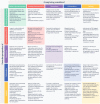Stakeholders' expectations of precision medicine: A qualitative study to identify areas of (mis)alignment
- PMID: 37599652
- PMCID: PMC10435831
- DOI: 10.1002/hsr2.1428
Stakeholders' expectations of precision medicine: A qualitative study to identify areas of (mis)alignment
Abstract
Background and aims: To sustainably address challenges in implementing precision medicine (PM), coordinated efforts of different stakeholders are required. Understanding their expectations represents a first key step toward aligning on future actions and strategies. Here, we aimed to explore the expectations of different stakeholders from themselves and each other regarding PM.
Methods: This collaborative qualitative study was initiated by the global multistakeholder consortium From Testing to Targeted Treatments (FT3). Structured interviews were conducted with participants from five stakeholder groups: patients/patient advocates, healthcare providers (HCPs), researchers, policymakers/regulators/payers and industry representatives. A broad reach across geography, roles, experiences, and disease areas was sought. Results were analyzed by grounded theory methodology.
Results: All stakeholders stated that optimal implementation of PM can only be achieved through collaboration; industry representatives were the biggest promoters of collaboration. Stakeholders agreed that PM should be implemented focusing on the patient's best interest; HCPs were seen as important gatekeepers for PM by interacting directly with patients, and policymakers/payers were perceived as the most important drivers of access to PM. Areas of misalignment included the role of industry in clinical trial design and in access to PM (perceived as important by patients, HCPs and policymakers but not by industry representatives), and the stakeholders responsible for elaborating guidelines on PM use (patients indicated policymakers, while researchers indicated themselves). Priorities for optimal PM implementation and suggested actions included the need for enhancing high-level policy focus, improving genomic literacy, optimizing the health technology assessment for PM, advocating for equitable access, promoting collaboration between industry and other stakeholder groups and development of reliable research standards.
Conclusion: Stakeholder expectations revealed in this study suggested that no stakeholder group can drive change on its own; a global, multistakeholder collaborative approach that brings together current programs and best practices to support universal access to PM is needed.
Keywords: equitable access; patient advocacy; precision medicine; priorities; stakeholder alignment; stakeholder expectations.
© 2023 The Authors. Health Science Reports published by Wiley Periodicals LLC.
Conflict of interest statement
Tanya Knott reports support for meeting attendance/speaker from Roche Products Ireland. Roche & Illumina grants for World CUP Awareness Week, and a leadership or fiduciary role in the FT3 board. Benjamin Horbach is an employee of and holds stock options in F. Hoffmann‐La Roche Ltd. James Creeden is an unpaid independent advisor to the FT3 board and owns Roche stock. Maximiliane Rauch‐Zumbrägel, Lidewij Vat, and Helena Harnik are collaborating with The Synergyst, a non‐profit organization, of which programs, including the FT3 program, are sponsored by the industry (list available at https://www.fromtestingtotargetedtreatments.org/). Zorana Maravic's organization received grants from BMS, Astellas, Daiichi‐Sankyo, Bayer, BI, Pierre Fabre and Seagen.
Figures





Similar articles
-
What do stakeholders expect from patient engagement: Are these expectations being met?Health Expect. 2018 Dec;21(6):1035-1045. doi: 10.1111/hex.12797. Epub 2018 Jun 1. Health Expect. 2018. PMID: 29858529 Free PMC article.
-
The future of Cochrane Neonatal.Early Hum Dev. 2020 Nov;150:105191. doi: 10.1016/j.earlhumdev.2020.105191. Epub 2020 Sep 12. Early Hum Dev. 2020. PMID: 33036834
-
How can we deliver on the promise of precision medicine in oncology and beyond? A practical roadmap for action.Health Sci Rep. 2023 Jun 22;6(6):e1349. doi: 10.1002/hsr2.1349. eCollection 2023 Jun. Health Sci Rep. 2023. PMID: 37359405 Free PMC article.
-
Healthcare stakeholders' perceptions and experiences of factors affecting the implementation of critical care telemedicine (CCT): qualitative evidence synthesis.Cochrane Database Syst Rev. 2021 Feb 18;2(2):CD012876. doi: 10.1002/14651858.CD012876.pub2. Cochrane Database Syst Rev. 2021. PMID: 33599282 Free PMC article.
-
THE FUTURE OF MEDICINE, healthcare innovation through precision medicine: policy case study of Qatar.Life Sci Soc Policy. 2020 Nov 1;16(1):12. doi: 10.1186/s40504-020-00107-1. Life Sci Soc Policy. 2020. PMID: 33129349 Free PMC article. Review.
Cited by
-
Evolving and Improving the Sustainability of Molecular Tumor Boards: The Value and Challenges.Cancers (Basel). 2024 Aug 20;16(16):2888. doi: 10.3390/cancers16162888. Cancers (Basel). 2024. PMID: 39199658 Free PMC article.
-
Implementing Personalized Cancer Medicine: Insights from a Qualitative Interview Study.J Pers Med. 2025 Apr 9;15(4):150. doi: 10.3390/jpm15040150. J Pers Med. 2025. PMID: 40278329 Free PMC article.
References
-
- Precision medicine. European Federation of Pharmaceutical Industries and Associations. Accessed July 15 2022. https://www.efpia.eu/about-medicines/development-of-medicines/precision-...
LinkOut - more resources
Full Text Sources

